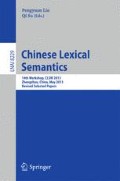Abstract
News articles in different languages on the same event are invaluable for analyzing standpoints and viewpoints in different countries. The major challenge to identify such closely related bilingual news articles is how to take full advantage of various information sources such as length, translation equivalence and publishing date. Accordingly, we propose a discriminative model for bilingual news alignment, which is capable of incorporating arbitrary information sources as features. Chinese word segmentation, Part-of-speech tagging and Named Entity Recognition technologies are used to calculate the semantic similarities between words or text as feature values. The feature weights are optimized using the minimum error rate training algorithm to directly correlate training objective to evaluation metric. Experiments on Chinese-English data show that our method significantly outperforms two strong baseline systems by 12.7% and 2.5%, respectively.
Access this chapter
Tax calculation will be finalised at checkout
Purchases are for personal use only
Preview
Unable to display preview. Download preview PDF.
References
Friburger, N., Maurel, D., Giacometti, A.: Textual similarity based on proper names. In: Proceedings of the Workshop Mathematical/Formal Methods in Information Retrieval (MFIR 2002) at the 25th ACM SIGIR Conference, pp. 155–167 (2002)
Huang, A.: Similarity Measures for Text Document Clustering. In: Proceedings of New Zealand Computer Science Research Student Conference (NZCSRSC), pp. 49–56 (2008)
Jagarlamudi, J., Daume III, H., Udupa, R.: From Bilingual Dictionaries to Interlingual Document Representations. In: Proceedings of the 49th Annual Meeting of the Association for Computational Linguistics (ACL): Shortpapers, pp. 147–152 (2011)
Liu, Y., Liu, Q., Lin, S.: Discriminative Word Alignment by Linear Modeling. Computational Linguistics 36(3), 303–339 (2010)
Mihalcea, R., Corley, C., Strapparava, C.: Corpus-based and Knowledge-based Measures of Text Semantic Similarity. Proceedings of American Association for Artificial Intelligence (AAAI) 6, 775–780 (2006)
Mihalcea, R., Tarau, P.: TextRank: Bringing Order into Texts. In: Proceedings of the Conference on Empirical Methods in Natural Language Processing (EMNLP), vol. 4(4) (2004)
Montalvo, S., Martínez, R., Casillas, A., Fresno, V.: Bilingual News Clustering Using Named Entities and Fuzzy Similarity. In: Matoušek, V., Mautner, P. (eds.) TSD 2007. LNCS (LNAI), vol. 4629, pp. 107–114. Springer, Heidelberg (2007)
Och, F.J.: Minimum error rate training in statistical machine translation. In: Proceedings of the 41st Annual Meeting on Association for Computational Linguistics (ACL), pp. 160–167 (2003)
Pouliquen, B., Steinberger, R., Ignat, C., Kasper, E., Temnikova, I.: Multilingual and cross-lingual news topic tracking. In: COLING 2004 Proceedings of the 20th International Conference on Computational Linguistics Article No. 959 (2004)
Pouliquen, B., Steinberger, R., Deguernel, O.: Story tracking: linking similar news over time and across languages. In: Proceedings of the Workshop on Multisource Multilingual Information Extraction and Summarization, pp. 49–56 (2008)
Steinberger, R., Pouliquen, B., Hagman, J.: Cross-lingual Document Similarity Calculation Using the Multilingual Thesaurus EUROVOC. In: Gelbukh, A. (ed.) CICLing 2002. LNCS, vol. 2276, pp. 415–424. Springer, Heidelberg (2002)
Vu, T., Aw, A.T., Zhang, M.: Feature-based Method for Document Alignment in Comparable News Corpora. In: Proceedings of the 12th Conference of the European Chapter of the ACL, pp. 843–851 (2009)
Yang, Y., Carbonell, J.G., Brown, R.D., Frederking, R.E.: Translingual Information Retrieval: Learning from Bilingual Corpora. Artificial Intelligence Journal Special Issue: Best of IJCAI 1997, 1–20 (1998)
Author information
Authors and Affiliations
Editor information
Editors and Affiliations
Rights and permissions
Copyright information
© 2013 Springer-Verlag Berlin Heidelberg
About this paper
Cite this paper
Wang, C., Liu, Y., Sun, M. (2013). Minimum Error Rate Training for Bilingual News Alignment. In: Liu, P., Su, Q. (eds) Chinese Lexical Semantics. CLSW 2013. Lecture Notes in Computer Science(), vol 8229. Springer, Berlin, Heidelberg. https://doi.org/10.1007/978-3-642-45185-0_45
Download citation
DOI: https://doi.org/10.1007/978-3-642-45185-0_45
Publisher Name: Springer, Berlin, Heidelberg
Print ISBN: 978-3-642-45184-3
Online ISBN: 978-3-642-45185-0
eBook Packages: Computer ScienceComputer Science (R0)

